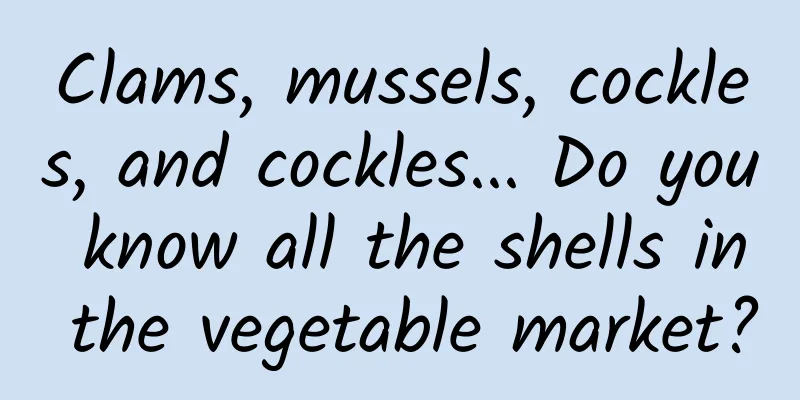Clams, mussels, cockles, and cockles... Do you know all the shells in the vegetable market?

|
Audit expert: Li Weiyang Well-known science writer ——"Hello, could you please weigh a pound of these clams for me?" ——"Which one? You want this clam? Okay!" ——"Uh... I want two pounds of this clam." ——"Clams? Oh, two pounds of clams, please wait~" The above awkward conversation is not only encountered by the editor. I believe that some friends who rarely cook may have encountered similar situations when they occasionally feel like going to the farmer's market to buy a big meal. A seafood stall selling various conch shells Source丨Author Seeing the various edible seashells in the market always makes people feel dazzled. Even if you have checked it online beforehand, it is still difficult to distinguish the various shells at the market. Even the words representing the various shells make people feel overwhelmed. Don’t believe it? Come, read it with me first: cockle, razor clam, mussel, oyster, clam, mussel… Why are they all mollusks wrapped in two hard shells called by different names? Today we will take a look at the various shellfish commonly seen in the vegetable market and their origins. 1 Clams and razor clams Clams and razor clams have opposite characteristics in appearance. Clams have hard and thick shells that can close the two shells tightly; while the shells of razor clams are not only as thin as paper, but also far less solid than those of clams. They can be broken by hand and cannot even completely wrap and protect their own flesh. Clams generally refer to several edible species under the family Anadaraidae, including hairy clams (Anadara subcrenata), mud clams (Tegillarca granosa, also known as blood clams, blood snails, silver clams, etc.), etc. Anadara broughtonii (aka ark shell) is sometimes regarded as hairy clams because it looks very similar to a large hairy clam. Hairy Clam Source: Wikipedia Hairy clams and mud clams are very popular edible shellfish. In addition to cooking them directly, a famous home-cooked dish "clams and cabbage" is made by stir-frying hairy clams with cabbage. Because of its delicious taste and large size, the giant clam is also a rare delicacy, especially popular in Japanese cuisine. Mud Clam Source: Wikipedia As for mud clams, they are a popular and delicious seafood. When cooking mud clams, many southern families first wash them, boil them in boiling water, and then peel them with their hands and eat them directly or dip them in sauce. They are said to be extremely delicious. However, since mud clams live on muddy tidal flats, they are prone to carry more bacteria. From the perspective of food safety, it is better to cook them thoroughly before eating. There are generally two types of clams commonly found in the market, namely, Sinonovacula constricta (also known as mud clams, hairy clams, etc.) and bamboo clams (Solen, common ones include S. grandis) and long bamboo clams (S. strictus). Salt-baked razor clams Source: Wikipedia Razor clams are easy to identify. If you see a shell that is rectangular, slightly light green, and has a large axe foot and water tube sticking out of it, you can basically confirm that it is a razor clam. Among them, the shell of the constricted razor clam is short and round, about 7 to 8 cm, while the bamboo razor clam can be more than ten centimeters long. Long bamboo clam Source: Wikipedia 2 Mussels and oysters Clams and oysters actually don't have any close relationship. The reason they are mentioned together is that many of my friends learned about these two types of shellfish from Chinese textbooks, one is "The Battle of the Snipe and the Clam" and the other is "My Uncle Jules". Mussels generally refer to various freshwater shellfish under the order Unionida, including the common Hyriopsis cumingii and Unio douglasiae, which are often referred to as "river clams". Although river clams can be eaten, cooking river clams requires the chef to have relatively high requirements for the heat and cooking skills. Generally speaking, we rarely see river clams sold for food purposes at the seafood stalls in the market. More of them are farmed river clams sold in various scenic spots with the gimmick of "on-site pearl collection". Dome Pearl Oyster Source: Wikipedia Compared to clams, which are difficult to cook, oysters are extremely popular and delicious shellfish. Oysters are oysters, generally referring to various shellfish under the superfamily Ostreoidea. Oysters usually grow on rocks, reefs, crab shells, and even other oyster shells. Their asymmetrical shapes make them very easy to identify. As long as you see shellfish with irregular gray-white shells at seafood stalls, they are definitely oysters. Pacific oyster Crassostrea gigas Source: Wikipedia There are many ways to eat oysters. Steaming, making soup, deep-frying the meat, grilling with garlic, or even eating them raw are all very suitable choices. I believe that after taking the lesson "My Uncle Jules", most of my friends will be curious about the legendary raw oysters. 3 Clams and cockles Speaking of clams, it is actually a very broad concept, because a considerable number of shellfish that can be seen at seafood stalls can be generally called "clams". In some contexts, the word "clams" can even refer to all shellfish, so it is not wrong to call "clams" "clams" at the beginning of this article. In taxonomy, there are several common edible shellfish that can be called "clams". For example, the Philippine clam (Ruditapes philippinarum, also known as the famous flower clam/flower clams/flower clams/clams) belonging to the family Ruditapes is the most common, most affordable, and has the highest market coverage. The square Mactra veneriformis (white clams) and the green clams (Mactra chinensis, also known as yellow clams) of the family Mactra (a bit confusing) are also the two most common edible clams. In addition, there are clams (Meretrix) and Paphia undulata (oil clams, sometimes confused with green clams). In recent years, the Pacific mud clam (Panopea generosa, also known as geoduck) from across the ocean has also become a common species in the market. 1-6: Pacific mud clams, wrinkled rib clams, green willow clams, wavy Paphia clams, Philippine curtain clams, square mako clams Source: Wikipedia Careful friends should have noticed that among the several types of "clams" mentioned above, many of them have the common name "such and such clams". In fact, the name "clam" or "clams" is not a more formal name for these common edible shellfish, but because fishermen and people living on the coast often call them "clams", in the vegetable market, it is more appropriate to call these "clams" "such and such clams" (it can also make you appear more sophisticated when bargaining). So, what is the real "clam"? In fact, it is called Corbicula fluminea. In taxonomy, the real "clam" refers to various bivalve molluscs under the Cyrenidae family of the order Cyrenales. Among them, the more common ones in my country are the Corbicula fluminea that live in freshwater. River Clams Source: Wikipedia River clams are not uncommon, but they are generally not sold separately in Beijing's vegetable markets. They are occasionally mixed with snails. In addition to river clams, there is sometimes another type of clam sold in Hainan's vegetable markets, which is the mangrove clam (Geloina erosa). 4 Mussels and Scallops The names of these two are much friendlier and at least very recognizable. The mussels in the Beijing market are generally blue mussels (Mytilus edulis), in addition to thick-shelled mussels (M. coruscus) and green mussels (Perna viridis, i.e. green mouth) with a bright green ring around the shell. Blue Mussel Source: Wikipedia The appearance of scallops is more intuitive. If you see a flat shell that is shaped like a round fan with two square "handles" at the end, it is definitely a scallop. When you open the scallop shell, you will find a crystal white adductor muscle inside. Even among the delicious edible shellfish, it is a very popular treasure. Scallops belong to the family of clams, and can be considered "clams" in a sense. There are many kinds of scallops commonly seen in the market, including the Yesso scallop (Mizuhopecten yessoensis), the thick-shell scallop (Mimachlamys crassicostata), the Chlamys farreri (Azumapecten farreri), etc. In addition, there is a triangular large shell that also has a crystal-clear and thick adductor muscle, which is the scallop (usually the Chinese scallop Atrina chinensis). The dried product of its adductor muscle is called scallop, which is also one of the seafood delicacies. Yesso scallop Source: Wikipedia As early as the infancy of human civilization, various shellfish provided primitive humans who ate raw meat and drank blood with readily available delicious protein, perfectly shaped containers and tools, beautifully colored decorations, and even currency with stable properties that was sufficient for circulation. Millions of years have passed, and although shells are no longer a necessity in people's lives, these small animals with hard shells are still an indispensable and delicious food on the human table. The history of humans eating and using shellfish has also been integrated into the depths of our civilization along with writing and language. Source: Digital Beijing Science Center Sign up |
<<: Zhang Fan: Strange Creatures in the Black Water
>>: Teaching a fish to walk, can you scientists be more boring?
Recommend
If you have this in your shopping cart, please delete it immediately!
One minute with the doctor, the postures are cons...
Short video operation: 5 rules for short video creation!
The rapid popularity of Tik Tok has promoted the ...
Whether iOS16 is worth updating depends on whether you like these features.
x dm, the long-awaited iOS16 official version is ...
Why can't you hit the fly?
In the kitchen or restaurant, you can always hear...
There are so many online promotion channels, which one is suitable for us?
I still remember when I first entered the industr...
The original project of Douyin and Xiaohongshu, even novices can operate it, easy to get started "Video Course"
Publish works through Xiaohongshu and direct traf...
Apple iPhone 7 A10 processor secrets: 11 times more powerful than Snapdragon 820
Although Apple's processors have always had o...
How to seize new opportunities in the workplace? Fangcunshan will help you make 72 changes in your career
How to seize new opportunities in the workplace? ...
It's an eyesore! After clicking on the information flow ad, I actually saw this...
I have talked about many information flow adverti...
30 high-quality cases in 18 industries, a must-read for information flow delivery!
This article shares with you 30 high-quality case...
Brand marketing promotion: How to produce better strategies?
In most cases, people tend to think in a positive...
The number of followers increased by 100,000. This is how Zhihu operates and promotes!
[Zhihu, is it worth doing? " Before answerin...
A complete online event promotion planning plan!
The Chinese Valentine's Day is coming soon. H...
What does the easternmost part of China look like?
2008 Heixiazi Island, which has been drifting for...
APP Promotion Tips | Make good use of Weibo light application and you can use big tricks without spending any money!
Preface The concept of light applications was pro...









